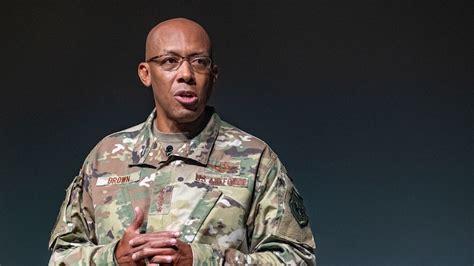Brown Replaced as Joint Chiefs Chairman: A Deep Dive into the Change of Leadership
The recent replacement of General Mark Milley as Chairman of the Joint Chiefs of Staff has sparked considerable discussion and analysis within the military and political landscape. This change in leadership marks a significant moment, demanding a closer look at the implications and the context surrounding this transition.
Understanding the Role of the Chairman of the Joint Chiefs of Staff
The Chairman of the Joint Chiefs of Staff (CJCS) serves as the highest-ranking military officer in the United States. This role is vitally important as it involves:
- Advising the President and Secretary of Defense: The CJCS provides vital military advice on matters of national security, strategy, and resource allocation.
- Leading the Joint Chiefs of Staff: This involves coordinating the activities of the various branches of the armed forces – Army, Navy, Air Force, Marines, and Space Force.
- Representing the military to the public and Congress: The CJCS is the public face of the military, often appearing before Congress and media to discuss matters of national importance.
The CJCS is not a commander in the traditional sense; they do not directly command troops. Instead, their influence comes from their advisory role and ability to coordinate the actions of the different services.
The Significance of General Milley's Departure
General Milley's tenure as CJCS saw him navigating numerous complex challenges, including:
- The withdrawal from Afghanistan: This highly controversial operation drew considerable criticism and prompted intense scrutiny of the military's strategic decision-making.
- Increased tensions with China and Russia: General Milley played a significant role in managing these complex geopolitical situations and maintaining communication channels.
- Modernizing the military: He championed efforts to modernize the armed forces and adapt to evolving technological threats.
His departure, therefore, marks the end of an era, and the incoming Chairman will face a unique set of challenges and opportunities.
Analyzing the Selection of the New Chairman
The selection process for the CJCS is rigorous and involves careful consideration by the President and Senate. Factors influencing the selection often include:
- Experience and Expertise: The candidate must possess extensive military experience and a proven track record of success in various operational and command positions.
- Leadership Qualities: Effective leadership is crucial for navigating complex political and military landscapes.
- Political Considerations: The President often considers the political implications and potential for consensus when making this appointment.
Understanding these factors provides context for understanding why a particular candidate was chosen. Analyzing the background and career trajectory of the new CJCS provides valuable insight into their approach and anticipated priorities.
Looking Ahead: Challenges and Opportunities
The incoming Chairman will likely face a number of significant challenges, including:
- Maintaining Strategic Stability: Navigating the complexities of great power competition and deterring potential adversaries will be a top priority.
- Modernizing the Military: Continuously adapting to the evolving technological landscape will remain a central focus.
- Addressing Internal Challenges: Internal reforms and improving morale within the armed forces will be necessary.
By understanding the context of the change in leadership, we can better anticipate the future direction of the US military. The transition provides an opportunity to analyze the strategic priorities of the new administration and the overall trajectory of national defense policy.
This analysis provides a framework for understanding the broader implications of General Milley's replacement as Chairman of the Joint Chiefs of Staff, highlighting the significance of the role and the challenges facing the incoming leader. Further research into the specific background and experience of the new Chairman will deepen this understanding.
